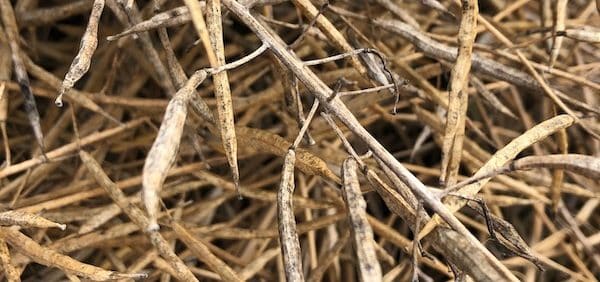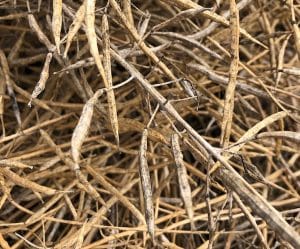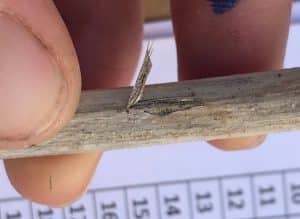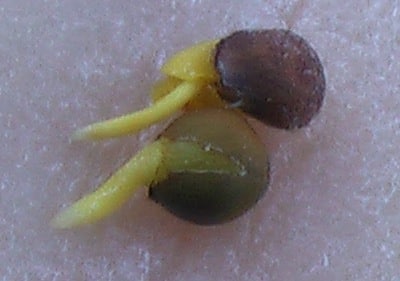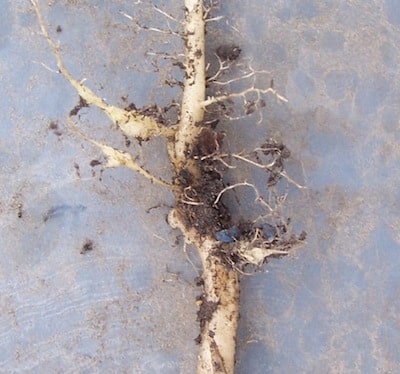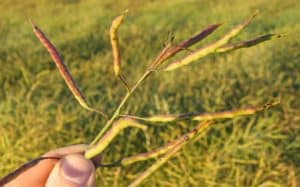Alternaria. Alternaria black spot infection is showing up more than usual, likely due to the extended harvest and moist conditions. Alternaria is a pathogen and a saprophyte, which means it infects living tissue and can feed off dying and dead plant material. It can continue to develop and darken plants as the crop sits in the windrow. Normally, the wax that covers B. napus stems and leaves keeps alternaria out, but as this wax degrades and breaks down as the plant matures and senesces, the pathogen is allowed to infect living and, then later, dead plant tissue. Alternaria rarely causes high yield loss in canola, but seed damage can occur when the lesion grows through the pod. It can cause pod splitting, too.Alternaria is among the large group saprophytic “sooty moulds,” which grow on dried down pods and can be found on seed surfaces after combining. Sooty mould is loose and crumbly and brushes off easily. Cool wet weather can increase alternaria infection, and rain splash can spread the disease to other plants. In cases of heavy alternaria infection (which is rare), early swathing may have an overall economic benefit to later swathing if alternaria has moved to pods. When infected areas make up 50% or more of the crop, swathing early may be the best way to salvage the yield in those infected plants. The disease can keep spreading on green material, and swathing hastens dry-down of the crop. Read more.
Verticillium stripe. CCC agronomy specialists are seeing more of it this year. Look for shredding of the outer stem tissue. As the stem’s outer skin peels back, you can see tiny black microsclerotia beneath the surface. Verticillium stripe becomes easier to identify after harvest when the stems are visibly grey and starting to shred. Read the Canola Encyclopedia chapter. Read more about how to tell verticillium from sclerotinia and blackleg.
Precocious germination or sprouting. After a drought-stressed summer, canola plants may have a lingering hormone response that can cause seed sprouting in the pods and regrowth of cut plants. As for a moisture response, canola seeds are much less likely than cereal seeds to sprout while in standing crop or windrows. It won’t germinate unless seed moisture drops down to around 10% moisture, then gets wet again. However, continuous wet weather in this situation can lead to canola seed sprouting. There is not much growers can do to avoid this, and combining early is not an option — given the storage risk. In grading, sprouted seed is categorized as “damaged” seed. No.1 canola can have a maximum 5% damaged seed. No.2 can have up to 12% damaged seed. No.3 can have up to 25% damaged. Aster yellows (AY) can also cause misshapen and malformed seeds, which often shrivel up and blow out of the combine. AY symptoms can include ‘precocious germination’ or sprouting in the pod. Read more about aster yellows.
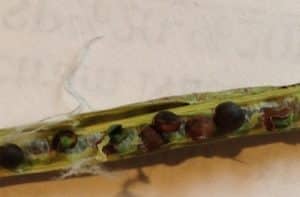
Clubroot scouting. You could find a whole range of galls this time of year, from completely degraded to small and white. These small galls are important to recognize because finding a few small galls may be better than a full scale infestation of large galls. Finding a few small galls (size rating ‘1’) gives the growers a chance to implement the clubroot management recipe before spore loads get too high. See ‘step 4’ here for the clubroot rating scale. Read more on how to identify clubroot.
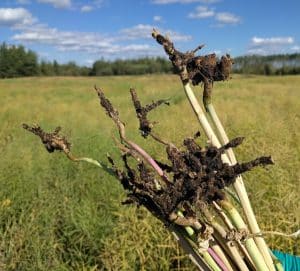
Sunscald. Sunscald can give green pods the appearance of colour change and maturity, but the seeds inside will often still be watery and green. Pod colour is not an accurate indicator of seed colour change.
Pod shatter. Not all pod-shatter resistant varieties are equal. Check standing canola for pod drop or pod shatter. There is no industry rating for pod shatter tolerance, so it may help to do your own analysis. Swathing is not really a backup option for canola left that late. With ripe canola plants, the risk of shattering loss rises by handling it twice — swathing AND combining — versus just combining. If a field beyond 80% seed colour change must be swathed, cut in moist conditions to limit shattering as much as possible.
